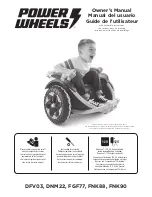
14
Battery
ELECTRICAL COMPONENTS: DIESEL
VEHICLES
WARNING
• If the battery case feels hot (approximately 125 °F (52 °C) or more), emits gases, or fluid boils from
vents, stop charging immediately. Failure to stop charging battery when any of these conditions are
present could result in an explosion, personal injury and/or damage to the battery.
• Do not disconnect the charger DC leads from the battery when the charger is on. The resulting arcing
between the DC leads and battery post could cause an explosion.
• If the charger must be stopped, disconnect the AC supply cord from the wall outlet before
disconnecting the DC leads from the battery. Allow the battery to cool to room temperature and
resume charging battery at a lower amp rate.
BATTERY INSTALLATION
See General Warnings on page 1-2.
1.
Place the battery into the vehicle with the battery posts facing the rear of the vehicle.
2.
Secure the battery to the vehicle with the clamp at the bottom of the battery. Tighten the clamp retaining bolt to
9 ft-lb (12.2 N·m).
3.
Connect battery.
See Side-Post Battery: Connecting the Battery – Gasoline/Diesel Vehicles on page 1-4.
See Top-Post Battery: Connecting the Battery- Gasoline/Diesel Vehicles on page 1-4.
BATTERY STORAGE
See General Warnings on page 1-2.
1.
Keep the battery clean and free of corrosion.
See Preventive Maintenance on page 14-22.
2.
Disconnect battery.
See Side-Post Battery: Disconnecting the Battery – Gasoline/Diesel Vehicles on page
1-3.
See Top-Post Battery: Disconnecting the Battery- Gasoline/Diesel Vehicles on page 1-4.
3.
Fully charge the battery prior to storage.
4.
Store in a cool, dry area. The colder the area in which the battery is stored, the less the battery will self-discharge.
A battery stored at 0 °F (-17.8 °C) will discharge very little over a four-month period. A battery stored at 80 °F
(27 °C) will have to be recharged every few weeks.
5.
Check the state of charge periodically. A battery that is discharged and left in a cold environment can freeze and
crack. If the specific gravity drops below 1.220, the battery should be recharged.
See following WARNING.
WARNING
• If the battery is frozen or the container is bulged, discard battery. A frozen battery can explode.
6.
The frequency of recharging required depends on the temperature of the storage area, but it is recommended
that the battery be monitored monthly for state of charge. Also, if the storage area is unheated in a cold
climate and recharging is required, it is recommended that the area be heated to at least 60 °F (16 °C) prior
to charging. The battery will not charge effectively in cold temperatures for the same reasons that it does not
discharge as rapidly in cold temperatures.
CHARGING A DEAD BATTERY
See General Warnings on page 1-2.
The charge coil is not designed to charge a dead battery. If the vehicle battery has become discharged, it must be
charged with a properly rated automotive type charger.
See following WARNING.
Page 14-24
2016 Carryall 1500/1700 and XRT 1550 Maintenance and Service Manual
Summary of Contents for Carryall 1500 2016
Page 2: ......
Page 432: ...NOTES...
Page 433: ...NOTES...
Page 434: ...NOTES...
Page 435: ......
Page 436: ......
































